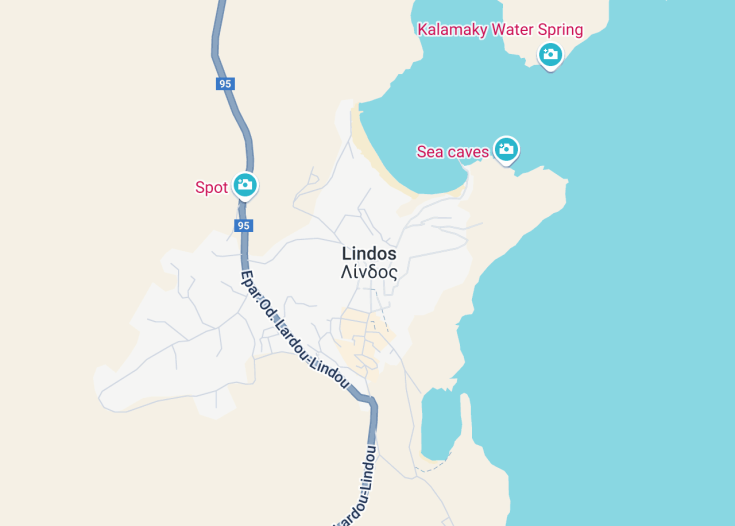Nestled on the eastern shores of Rhodes Island, Lindos is a captivating blend of ancient history and modern leisure. Known for its striking acropolis towering over white-washed houses, Lindos offers a picturesque escape into the heart of Greek antiquity.
The village’s narrow, cobblestone streets, teeming with vibrant boutiques and quaint eateries, lead to stunning beaches that stretch along crystal-clear waters. This destination not only delights history enthusiasts with its rich past and archaeological sites but also beckons beach lovers and culture seekers alike.
Make sure to visit early in the morning to explore the Acropolis of Lindos without the afternoon crowds and the heat intensifying your experience.
Wear comfortable shoes as the charming but uneven cobblestone streets of Lindos require steady footwear for the best exploration experience.
Top things to do & see in Lindos
Select the following sights and activities to discover best tickets and tours available in Lindos.
Lindos: A Glimpse of Ancient Beauty
| Country | Greece |
| Time in Lindos | GMT+2 |
| Language spoken | Greek |
| Population | 4,015 (source: Latest Census) |
| Currency | Euro (€, EUR) |
| Airports |
|
Lindos, located on the island of Rhodes in Greece, offers a unique blend of ancient history and stunning natural beauty. This picturesque village is crowned by a medieval fortress yet peppered with white-washed houses that climb up its hillside, leading to an ancient acropolis. Renowned for its archaeological sites dating back to 300 BC, Lindos captivates visitors with its rich history and breathtaking views of the Aegean Sea.
Where is Lindos?
Lindos is situated on the eastern coast of the island of Rhodes in Greece.
Distances:
| Route | Distance by car | Time by car |
| Rhodes to Lindos | 30 miles (48 km) | 50 minutes |
| Athens to Lindos (via ferry) | 261 miles (420 km) | Approx. 14 hours (including ferry travel) |
What is Lindos famous for?
Lindos is famous for its ancient acropolis, stunning beaches, and its enduring traditional architecture. It’s a cultural tapestry rich with historical and modern significance.
History
Prehistoric and Ancient Periods
Lindos, a jewel on the island of Rhodes in Greece, boasts a rich history that dates back to the prehistoric era. Archaeological evidence suggests that the area was inhabited in the Neolithic period, around 3000 BC. By the 10th century BC, Lindos had become a major trading center due to its strategic position in the southeastern Aegean Sea. The town was also known for its temple dedicated to Athena Lindia, which became an important religious hub during the Dorian Hexapolis—a confederation of six Dorian cities.
Classical to Byzantine Era
Throughout the Classical period, Lindos thrived due to its robust maritime commerce and its shipyards. It was during this time that the monumental acropolis of Lindos began to take shape, with structures such as the Temple of Athena Lindia being constructed in the Doric style of architecture. The town’s prosperity continued into the Hellenistic period, where it maintained its importance as a cultural and economic center. The arrival of the Romans in 43 BC saw Lindos retaining its autonomy, a testament to its significance. The Byzantine era heralded the construction of the Church of St. John on the acropolis, marking an ongoing human presence.
Medieval to Modern Times
During the medieval period, the Knights of St. John occupied Rhodes and fortified Lindos, leaving behind the massive castle walls that are a visitor draw today. Under Ottoman rule from 1522, Lindos experienced a decline in its commercial prosperity but remained a significant local center. It was not until the Italian occupation in the 20th century that archaeological investigations began, uncovering much of its glorious classical past. Presently, Lindos is recognized not only for its historical and archaeological significance but also as a vibrant tourist destination that respects and preserves its rich heritage.
Visit Lindos
What to see and do in Lindos
When visiting Lindos, one is advised to first explore its ancient acropolis. This architectural marvel offers panoramic views of the surrounding sea and houses the Temple of Athena Lindia.
Descend from the acropolis to wander through the labyrinth of narrow streets of the town, characterized by charming white houses and pebbled courtyards.
- Visit the old captain’s houses, showcasing 17th-century frescoes
- Relax on the stunning beaches such as St. Paul’s Bay
- Explore the small, atmospheric Byzantine Church of the Panagia
Festivals in Lindos
Lindos is ripe with cultural expression, showcased beautifully in its various festivals. Notably, the Lindos Festival, held every summer, involves a series of classical music concerts and artistic performances set in the ancient theatre of the acropolis. This provides a mesmerizing fusion of historic ambience with vibrant cultural exhibits.
Best time to visit Lindos
The ideal time to explore Lindos is during the spring (April to June) or fall (September to October). These months offer mild weather, fewer crowds, and the natural beauty of the region is at its peak, making sightseeing and outdoor activities extremely pleasant.
Is Lindos worth visiting?
Lindos, with its rich tapestry of history, stunning natural landscapes, and vibrant local culture, is undoubtedly worth visiting. The town offers a unique glimpse into the civilizations of the past while providing all the amenities needed for a modern getaway.
Whether one is interested in historical tours, scenic walks, or simply relaxing by the crystal-clear waters of its beaches, Lindos caters to all and leaves an indelible mark on its visitors.










